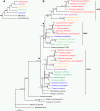Adaptive evolution of the chrysanthemyl diphosphate synthase gene involved in irregular monoterpene metabolism
- PMID: 23137178
- PMCID: PMC3518182
- DOI: 10.1186/1471-2148-12-214
Adaptive evolution of the chrysanthemyl diphosphate synthase gene involved in irregular monoterpene metabolism
Abstract
Background: Chrysanthemyl diphosphate synthase (CDS) is a key enzyme in biosynthetic pathways producing pyrethrins and irregular monoterpenes. These compounds are confined to plants of the tribe Anthemideae of the Asteraceae, and play an important role in defending the plants against herbivorous insects. It has been proposed that the CDS genes arose from duplication of the farnesyl diphosphate synthase (FDS) gene and have different function from FDSs. However, the duplication time toward the origin of CDS and the evolutionary force behind the functional divergence of the CDS gene are still unknown.
Results: Two duplication events were detected in the evolutionary history of the FDS gene family in the Asteraceae, and the second duplication led to the origin of CDS. CDS occurred after the divergence of the tribe Mutisieae from other tribes of Asteraceae but before the birth of the Anthemideae tribe. After its origin, CDS accumulated four mutations in sites homologous to the substrate-binding and catalysis sites of FDS. Of these, two sites were involved in the binding of the nucleophilic substrate isopentenyl diphosphate in FDS. Maximum likelihood analyses showed that some sites in CDS were under positive selection and were scattered throughout primary sequences, whereas in the three-dimensional structure model they clustered in the large central cavity.
Conclusion: Positive selection associated with gene duplication played a major role in the evolution of CDS.
Figures


Similar articles
-
Structure-Function Studies of Artemisia tridentata Farnesyl Diphosphate Synthase and Chrysanthemyl Diphosphate Synthase by Site-Directed Mutagenesis and Morphogenesis.J Am Chem Soc. 2017 Oct 18;139(41):14556-14567. doi: 10.1021/jacs.7b07608. Epub 2017 Oct 5. J Am Chem Soc. 2017. PMID: 28926242
-
Maize cDNAs expressed in endosperm encode functional farnesyl diphosphate synthase with geranylgeranyl diphosphate synthase activity.Plant Physiol. 2006 May;141(1):220-31. doi: 10.1104/pp.106.077008. Epub 2006 Mar 31. Plant Physiol. 2006. PMID: 16581875 Free PMC article.
-
Cloning and sequence analysis of the Blumea balsamifera DC farnesyl diphosphate synthase gene.Genet Mol Res. 2014 Nov 27;13(4):9874-82. doi: 10.4238/2014.November.27.15. Genet Mol Res. 2014. PMID: 25501197
-
Enzymes encoded by the farnesyl diphosphate synthase gene family in the Big Sagebrush Artemisia tridentata ssp. spiciformis.J Biol Chem. 2003 Aug 22;278(34):32132-40. doi: 10.1074/jbc.M213045200. Epub 2003 Jun 2. J Biol Chem. 2003. PMID: 12782626
-
Farnesyl pyrophosphate synthase: a key enzyme in isoprenoid biosynthetic pathway and potential molecular target for drug development.N Biotechnol. 2013 Jan 25;30(2):114-23. doi: 10.1016/j.nbt.2012.07.001. Epub 2012 Jul 25. N Biotechnol. 2013. PMID: 22842101 Review.
Cited by
-
Divergence and adaptive evolution of the gibberellin oxidase genes in plants.BMC Evol Biol. 2015 Sep 29;15:207. doi: 10.1186/s12862-015-0490-2. BMC Evol Biol. 2015. PMID: 26416509 Free PMC article.
-
Development of Microsatellite Markers for Tanacetum cinerariifolium (Trevis.) Sch. Bip., a Plant with a Large and Highly Repetitive Genome.Plants (Basel). 2022 Jul 5;11(13):1778. doi: 10.3390/plants11131778. Plants (Basel). 2022. PMID: 35807729 Free PMC article.
-
Evolutionary Analysis of Plastid Genomes of Seven Lonicera L. Species: Implications for Sequence Divergence and Phylogenetic Relationships.Int J Mol Sci. 2018 Dec 14;19(12):4039. doi: 10.3390/ijms19124039. Int J Mol Sci. 2018. PMID: 30558106 Free PMC article.
-
Identification of LecRLK gene family in Cerasus humilis through genomic-transcriptomic data mining and expression analyses.PLoS One. 2021 Jul 12;16(7):e0254535. doi: 10.1371/journal.pone.0254535. eCollection 2021. PLoS One. 2021. PMID: 34252163 Free PMC article.
-
Biosynthesis of irregular monoterpene lavandulol in Saccharomyces cerevisiae.Synth Syst Biotechnol. 2025 Jun 19;10(4):1267-1274. doi: 10.1016/j.synbio.2025.06.001. eCollection 2025 Dec. Synth Syst Biotechnol. 2025. PMID: 40792074 Free PMC article.
References
-
- Rivera SB, Swedlund BD, King GJ, Bell RN, Hussey CE, Shattuck-Eidens DM, Wrobel WM, Peiser GD, Poulter CD. Chrysanthemyl diphosphate synthase: Isolation of the gene and characterization of the recombinant non-head-to-tail monoterpene synthase from Chrysanthemum cinerariaefolium. Proc Natl Acad Sci USA. 2001;98(8):4373–4378. doi: 10.1073/pnas.071543598. - DOI - PMC - PubMed
-
- Kikuta Y, Ueda H, Nakayama K, Katsuda Y, Ozawa R, Takabayashi J, Hatanaka A, Matsuda K. Specific regulation of pyrethrin biosynthesis in Chrysanthemum cinerariaefolium by a blend of volatiles emitted from artificially damaged conspecific Plants. Plant Cell Physiol. 2011;52(3):588–596. doi: 10.1093/pcp/pcr017. - DOI - PubMed
-
- Epstein WW, Poulter CD. Survey of some irregular monoterpenes and their biogenetic analogies to presqualene alcohol. Phytochemistry. 1973;12(4):737–747. doi: 10.1016/0031-9422(73)80670-3. - DOI
Publication types
MeSH terms
Substances
LinkOut - more resources
Full Text Sources
Other Literature Sources

